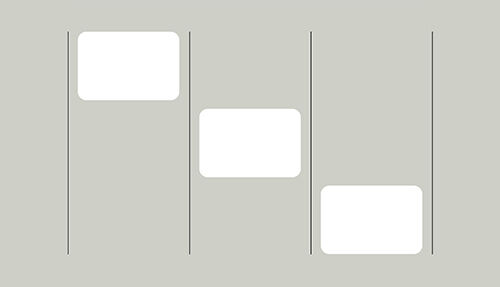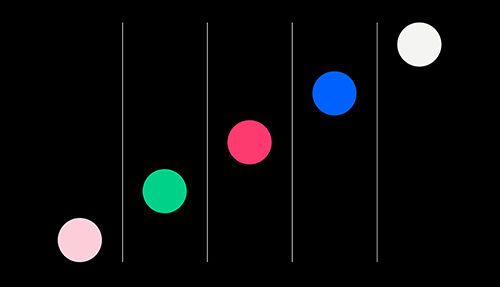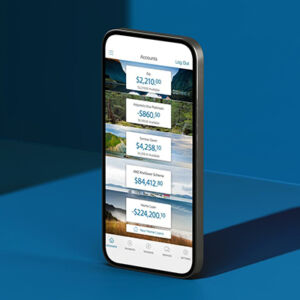Smart habits to borrow from creative people.

Do you find yourself getting stuck when it’s time to plan the next quarter’s comms strategy or campaigns? Or do you ever lack the inspiration to make a creative brief as great as you want it to be? I spoke with some of Dave Clark’s creative people across graphic design, digital design and motion design teams to hear what habits they follow – and that you can borrow – to create great work.
Set yourself up for success from the outset
Antoinette Le Vaillant, Design director, gets the best creative result when she fully understands the question at the start. “You need to know the parameters and the goal because there could be an unexpected way to get to the result. Context is so important because it informs all your decisions. Without it, you’re like flotsam floating around in an ocean,” she says.
Simon Smith, Digital Design Director, and Michael Frogley, the Motion Director, agree. Simon says, "The more we know up front, the better the final outcome will be. Limitations can often become strengths provided they're considered from the outset." Michael adds, “Read what’s been done before for similar projects. Look into what the competition is doing and then start channeling the new ideas.”
It’s also worth taking the time to physically set yourself up for success by working in a comfortable space and having inspirational things around you. Zoë Hodgens, Senior Designer, listens to podcasts. A narrative going on in the background helps her focus on design. “I also create an Illustrator file and fill it up with colours, fonts and research material that will help me begin building concepts. Start broad and narrow down to make sure you don’t miss any good avenues,” she says. Simon assembles tools as well. He’ll choose colours, photography, patterns and an icon style – a palette of things to work with immediately.
Antoinette says that it’s much easier to get going when you’ve got the brief, assets, and research that will inspire you. “Try to get all these things together so your process doesn’t have to be interrupted. This preparation upfront will give you the confidence you need to create something great.”
Collaborate for new angles and ideas
While you might be responsible for completing a project, you certainly shouldn’t work on it in isolation. Michael says that one of the most important things the motion design team does is talk together. “If I get stuck with something, I’ll throw it over to someone else and ask what they think or if they have another way of doing it. We use Slack to bounce ideas between our teams in Auckland, Wellington, Sydney, Melbourne and Singapore. So we can be influenced by their habits and cultures."
Zoë always wants other people’s opinions and doesn’t like working in isolation. “I know I don’t have all the answers and when you talk to others, you realise there’s more than one way to do something.”
Simon thinks that a group dynamic is really important and says, “I like when someone walks past my desk, looks over my shoulder and says, ‘Oh that’s cool’. I can then have the confidence to think, ‘Yeah it is’, and all of a sudden you have a line in the sand and more ideas develop from that one thing. Just a passing comment can trigger this little cascade of creative decision making.”
Absorb, iterate and walk away
Of course there are always urgent projects to get finished as soon as possible. But when a plan, strategy, campaign, or product or service release is really important and you’ve got the time, use that time to your creative advantage.
“Your brain works in the background all the time. You might have 20 hours on something but don’t use them all on the first two days. Space it out. Reflect and redo. Your first iteration is expected and can be average. It’s in adapting that the genius comes through,” explains Antoinette.
Simon adds, “Dave Clark sometimes tells me about projects before I start working on them. I like that because your brain will do amazing things identifying and solving problems if it just has a little seed.”
“Don’t just sit at your desk and hope the best idea will drop in your lap,” says Michael. “From a technical point of view, it’s like defragging a hard drive. You have all this info coming in and you go off cycling, walking, sleeping on it overnight, whatever, and in the background your brain is putting things in order. You come back and the right option is right there. It’s often when you’re not paying attention that you get the best ideas.”
Simon encourages designers to get to a ‘bad’ draft. “I tell them to stop fussing about the perfect website navigation for instance and just get to a point where the main elements are there. As soon as you’re done, you’ll feel awesome and can then make phase two and it will be better.”
Michael continues on that theme, “Get the first thing done, get context, then embellish the story. The pressure is off, now you can iterate. And don’t be afraid to be influenced by the research you do and what’s come before. Find something close to what you’re trying to create and work over the top of it. In a few hours, you’ve got something original.”
It’s also helpful to leave your medium. If you’re putting together a Google doc or PowerPoint, pick up a sketch pad and jot down your thoughts. Or try creating a chart or diagram instead of a list of bullet points. Reverse context to generate a novel solution.
Ask for and be open to feedback
While these designers present work, get feedback and act on that feedback every day, they all think there’s a lot of value in asking for the opinion of others.
Zoë says, “As designers, we have an inner critic that helps us discern whether something is good or bad. That’s inspiring and you need to trust that critic. But it’s also good to get an outside view and talk to different people with different knowledge.”
“Don’t think that you can only ask for feedback when something is finished,” says Simon. “Have a quiet word with someone you trust about a specific element that’s giving you trouble. It doesn’t have to be a protracted conversation, just help with one decision.”
For Zoë, direct feedback is best. “If someone’s feedback bothers me a little bit, that’s my problem, but at least I know if it’s right to invest my time in the direction I was going.”
Michael’s team shares work on the wall. “It’s great for feedback during a project and it’s good for future work. When you spend a lot of time on something, that work shouldn’t be wasted. You can tweak and reform it for something else.”
When you’re part of a team, it’s nice to share your expertise and take on feedback from people with smarts in other areas. “Getting those outside views and having the backup of your team will assure that you stay on track to get the best possible result,” says Antoinette.







